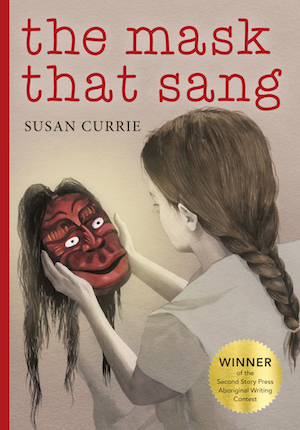| ________________
CM . . .
. Volume XXIII Number 8. . . .October 28, 2016
excerpt:
Most people would panic should they enter into an inherited home and suddenly believe they could hear voices singing to them. Upon discovering the item from which the voices originate, no doubt the item would be discarded as fast as possible, likely while one is on the phone booking an appointment with a psychologist. Unless of course, you are The Mask That Sang’s protagonist, Cass Foster. Only in the fifth grade, Cass happens upon the mask in a chest of drawers located inside the home of her deceased grandmother. Thus unfolds the novel’s plot which is filled with potential, but unfortunately fails to live up to it. The novel itself is short (a little under 200 pages), which is very non-intimidating for kids who are just beginning to foray into novels with longer storylines. The Mask That Sang tells the story of Cass, a bullied girl with a mother who had Cass while just a teenager and who now struggles to find a job to support the two of them. However, the story, itself, is about roots—specifically, Aboriginal lineage, and the influence these roots can have on an individual. Author Susan Currie should be praised for her attempt at writing for an often marginalized population, Aboriginal children, a group often lost to modern storytelling (or alternatively, heavily romanticized). Currie approaches the topic with respect and understanding, clearly having done her research on customs and even dialect of these characters (e.g. Cass’ Aborginal classmate, Degan, refers to his mother’s friend as an “aunt”). Currie utilizes vivid descriptions and many chapter cliffhangers, with the latter likely propelling a child reader through the novel in no time. However, the novel is not without its flaws. Seemingly unwilling to go past surface tension, this story suffers largely from “iceberg syndrome” in that The Mask That Sang only tells 10 percent of a story, as opposed to delving a little deeper into dramatic issues and revealing the other 90 percent. The story only ever touches on “surface level” problems, and every conflict between characters is largely petty and/or neatly resolved within a couple of chapters. Known as “Chekhov’s gun” (the principle that if a gun is introduced in a fictional story, it must as some point be shot or go off), this novel fails on almost all accounts, introducing potentially dramatic elements of fiction, and then deciding against exploring them. As a reader, it’s incredibly disappointing to see a novel with so much potential seemingly shy away from it at nearly every turn. While The Mask That Sang would, I believe, be an enjoyable novel for children, highlighting the importance of befriending the marginalized, any reader aged 13 or older is likely going to be frustrated with missed opportunities in what could have been a very impressive novel. Recommended. Callie Martin holds a Bachelor’s Degree in English and will begin studying for her Master’s degree in Cinema and Media Studies this fall.
To comment
on this title or this review, send mail to cm@umanitoba.ca.
Copyright © the Manitoba Library Association. Reproduction for personal
use is permitted only if this copyright notice is maintained. Any
other reproduction is prohibited without permission.
Next Review | Table of Contents For This Issue - October 28, 2016 |
